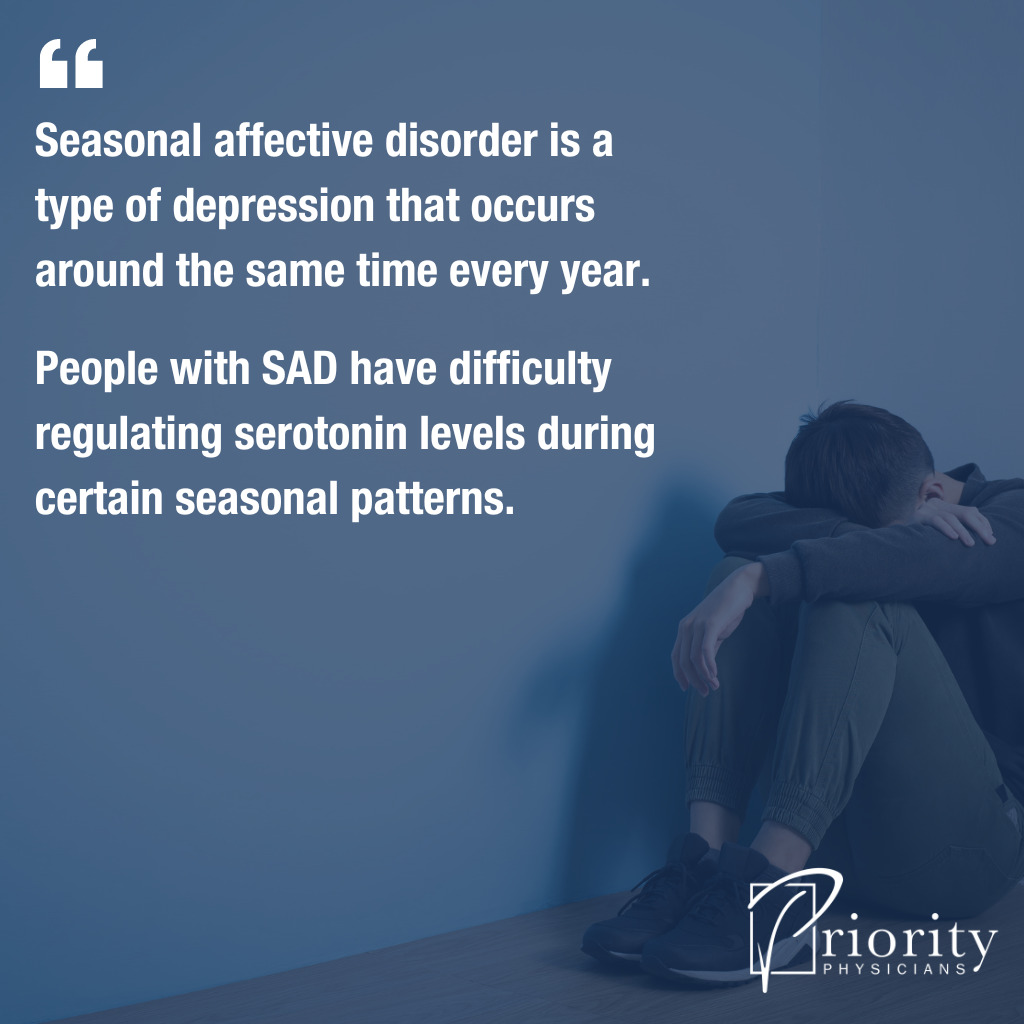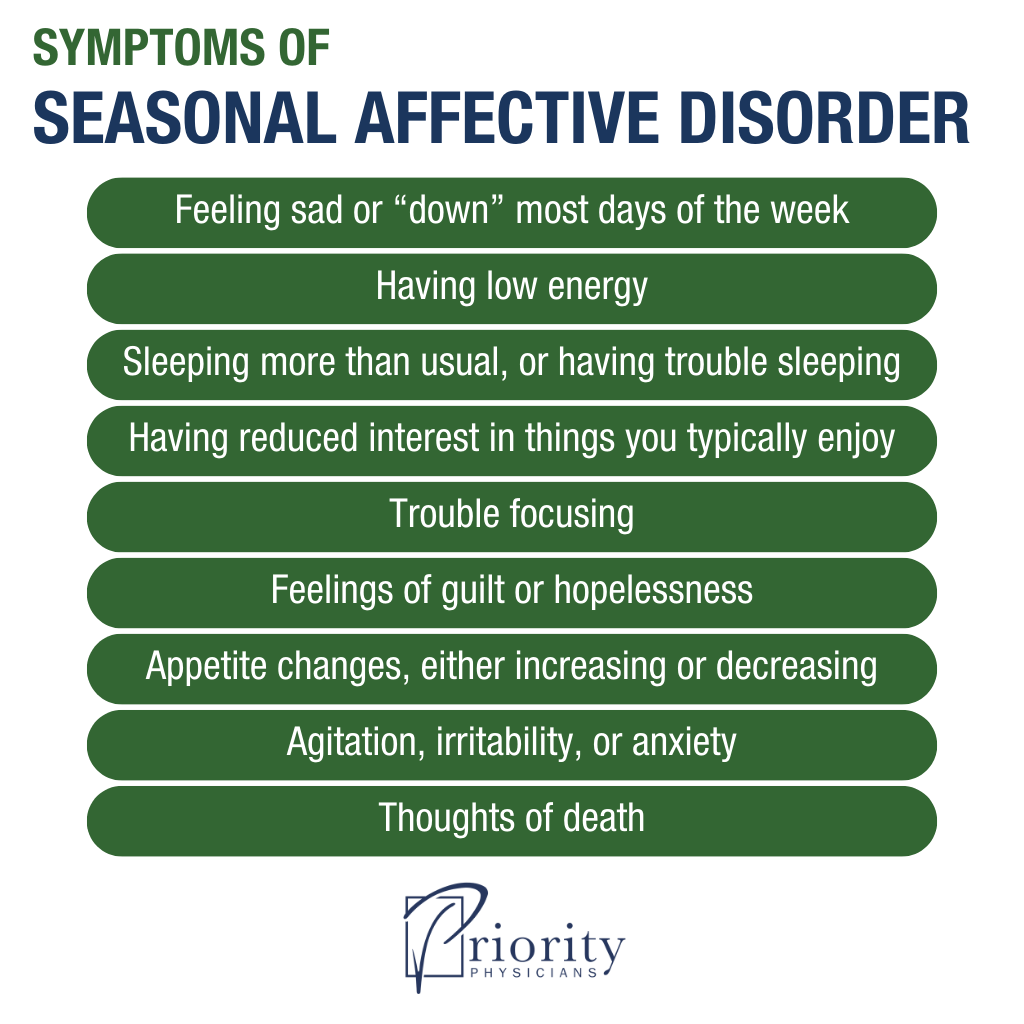Seasonal affective disorder, or SAD, has an ironic name.
This disorder is absolutely real — time of year has been shown to have a legitimate impact on mood. SAD symptoms appear more commonly in the fall and winter months and typically improve with the arrival of spring. That said, cases of SAD in the spring and summer months aren’t unheard of.
The disorder is quite common, affecting about 5% of adults in the United States and lasting about 40% of the year. Women are more likely to experience seasonal affective disorder than men.
So, what is seasonal affective disorder, really? Are there vitamins or supplements for seasonal affective disorder? Does physical exercise help? Keep scrolling to find out.

What Is Seasonal Affective Disorder?
Seasonal affective disorder is a type of depression that occurs around the same time every year. People with SAD have difficulty regulating their serotonin levels during certain seasonal patterns. Symptoms often include:
- Feeling sad or “down” most days of the week
- Having low energy
- Sleeping more than usual, or having trouble sleeping
- Having reduced interest in things you typically enjoy
- Trouble focusing
- Feelings of guilt or hopelessness
- Thoughts of death
- Appetite changes, either increasing or decreasing
- Agitation, irritability, or anxiety

Typically, symptoms of seasonal affective disorder are severe enough to impact your relationships and daily functions. Your job performance, friendships, and home relationships may suffer as you’re working through this condition.
It’s important to distinguish seasonal affective disorder from other types of depression and from the general malaise that can accompany the changing of seasons. Seasonal affective disorder is based on a historical pattern of depression during specific periods. If there’s no routine of depressive periods happening around the same time annually, the condition isn’t considered seasonal affective disorder.
Combating Seasonal Affective Disorder
There are several ways to manage and combat seasonal affective disorder. We’ll explore a few below.
Lifestyle Factors
Diet: Your diet plays an important role in managing SAD symptoms. Try to limit your consumption of processed foods, sugars, and alcohol to keep your body functioning efficiently. Aim to incorporate plenty of fiber, a variety of vegetables and fruits, lean protein, and healthy fats into your meals.
Movement: When it comes to seasonal affective disorder, physical exercise is important, but your movement doesn’t have to be strenuous to have a positive impact on symptoms. Even walking at a conversational pace for an average of 150 minutes per week can provide the same neurotransmitter production you’d get from an antidepressant.
Sleep: Our brains form memories and regenerate many neurotransmitters while sleeping. Aim to get seven to nine hours of sleep per night so you can wake up feeling refreshed and restored.
Stress Reduction: To rebalance hormone levels and ease feelings of anxiety, try practicing some mindfulness exercises and breathing techniques.
Light Therapy
Light therapy is an excellent, non-pharmaceutical method of combatting seasonal affective disorder. There are plenty of options available through retailers like Amazon. An ideal device for SAD light therapy should produce 10,000 lux and very low or no levels of UV waves.
To effectively manage SAD using light therapy, place the light 16–24 inches away from your face for 20–30 minutes within an hour of waking up. You’ll want to keep your eyes open for maximum efficacy, but don’t look directly into the light.
Vitamins and Supplements for Seasonal Affective Disorder
You should be seeing your doctor regularly and monitoring your levels of vitamins as part of your lab work, especially vitamin D.
Always discuss any dietary supplements or medications for seasonal affective disorder with your doctor. Some of the same medications that are prescribed for general depression and anxiety are also applicable for SAD, and your doctor will be able to recommend the best ones for you.
Therapy
Therapy is a big commitment, but it can produce incredibly helpful results. Finding the right fit is key; there are a variety of therapy styles that may or may not work for you. The goal of therapy should be to learn tools to positively manage some of the thoughts and feelings that are characteristic of SAD.
Seasonal Affective Disorder: Final Thoughts
Seasonal affective disorder is a condition that impacts a significant number of adults annually. While it shares symptoms with general depression, its occurrence is consistently governed by the time of year.
To determine which treatment options are best for your seasonal affective disorder, talk to a healthcare professional who can design the best plan for your individual needs.

